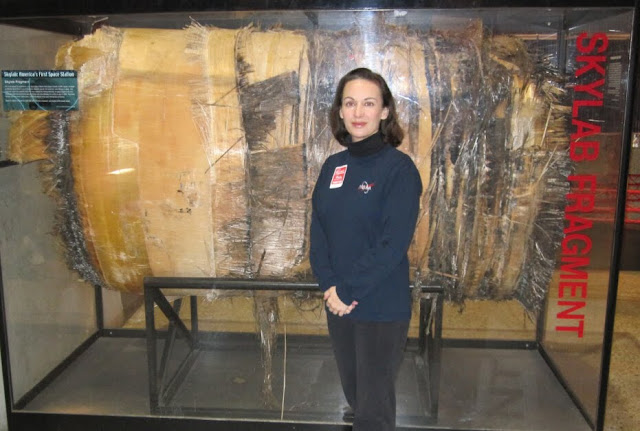Happy 40th Anniversary to SKYLAB, the first American space station! I'm continually amazed at how Skylab Missions, sandwiched between Apollo and the Space Shuttle programs, tends to be the Forgotten Orbiting Tin Can.
Compared to modules on other stations, and short-term capsules used in Mercury, Gemini, & Apollo -- Skylab practically had a ballroom! Most of the best "micro-gravity acrobatics" videos came from this amazing program in the mid-1970s.
I was born just as the Moon landing program was revving up; my parents tell me I watched lunar footage on television, though I have no recollection. Honestly, Skylab is the first program I can remember seeing on television as a child: how they ran experiments in weightlessness, how the station hosted the first medical doctor in space (astronaut Joseph Kerwin) – and of course, how debris unfortunately plummeted onto Western Australia in July of 1979.
They had animals in space! I found that captivating, and plied my father with questions about how fish could swim in space, how spiders adapted, and how humans were affected by the longest space flights up to that time. Skylab was the first program to study bones, muscles, blood, heart function,and metabolism.
Skylab featured in my October 1974 issue of National Geographic,
which called the space station a "flying Dutch windmill"...
which called the space station a "flying Dutch windmill"...
The three manned Skylab missions:
Skylab 2 (May 25 - Jun 22, 1973) - Pete Conrad, Paul Weitz and Joe Kerwin flew longest duration spaceflight at the time, to study fluid-electrolyte changes, cardiovascular changes, sleep patterns, exercise and space adaptation syndrome.
Skylab 3 (Jul 28 - Sep 25, 1973) - Alan Bean, Owen Garriott and Jack Lousma flew to conduct in-flight girth measurements, headward fluid shift, arterial blood flow tests, hemoglobin and urine specific gravity tests; animal experiments included the first fish in space (mummichog fingerlings and eggs), pocket mice, cellular organisms, fruit flies and the first two Garden spiders, Arabella and Anita.
Skylab 4 (Nov 16, 73 - Feb 8, 74) - Gerald Carr, William Pogue, and Edward Gibson flew to study body weight changes, bone and muscle deterioration, tissue dehydration, orthostatic intolerance, and factors determining severity of space sickness symptoms and possible countermeasures.
One of my favorite astronaut pictures of all time!
Dr. Joe Kerwin giving weightless medical exam to Pete Conrad
Dr. Joe Kerwin giving weightless medical exam to Pete Conrad
More missions to Skylab were planned, following a refurbishment project and orbital-boost, compliments of the newly-proposed crafts called "Space Shuttles". However, construction was delayed, so NASA had no choice but to allow Skylab to re-enter Earth's atmosphere. On July 11, 1979, Skylab disintegrated as it fell toward Western Australia, sonic booms and all.
As fiery pieces smashed into the ground near the mining town of Esperance, inhabitants Dorothy and Mervin Andre collected spherical containers, various strips and shards of metal, a hundred-pound door hatch, and an oxygen tank similar to the one I'm posing with below.

Me with a big ol' hunk of what was left of Skylab
NASA Marshall Space Flight Center, Alabama
NASA Marshall Space Flight Center, Alabama
When the American recovery team arrived in Australia to survey the debris field of the fallen station, Mervin Andre (town council president at the time), issued them a ticket for littering. FROM SPACE. That always cracked me up! I don't recall hearing that story on television at the time, but merely remember thinking the Australian government was remarkably cool about the whole thing, having announced from the capital city of Canberra that Skylab had "fallen harmlessly into the ocean" while pieces were in fact raining down over The Outback.
The Andre couple now operate The Skylab Museum of Australia, which gets about 12,000 annual visitors. Seems they’re proud and happy to share their salvage, and even happier to remind Americans that the ticket remained unpaid for three decades.
In July of 2009, they held an anniversary celebration whereby two American radio hosts, Barker & Barley of Highway Radio, challenged their morning listeners to raise the $400 necessary to pay the littering fine on NASA’s behalf, finally settling the ticket 30 years later.





































































